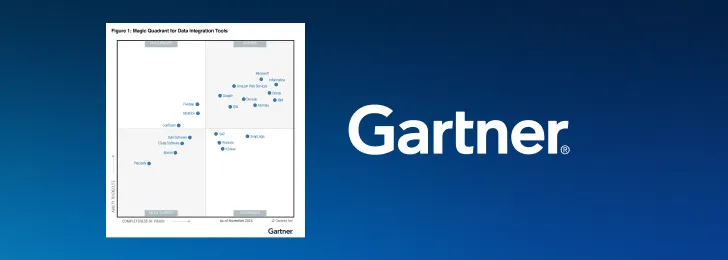
Data is more prolific than ever, spread across databases, file stores, business applications and myriad other sources. Regardless of their original source, organizations have applications and services that they rely on for business functions and analytics, but loading data into those services to maintain integrity, accessibility, and continuity is a common challenge. Salesforce is a popular platform for customer relationship management (CRM) that provides tools for working with external data within the platform, consolidating data to meet the organization's specific needs, workflows, and data structures.
In this article, we'll discuss the two Salesforce tools used to move external data into Salesforce. By sharing the strengths and weaknesses of each option, we guide you toward making an informed decision that not only meets your immediate data migration needs but also positions your Salesforce ecosystem for long-term success and scalability. We'll end the article with an introduction to CData Sync, which supports reverse ETL of data from SQL Server and Snowflake into Salesforce.
Understanding the Salesforce Data Import Wizard and Data Loader
Salesforce offers a suite of tools designed to facilitate efficient data migration, ensuring that organizations can easily incorporate business information in their Salesforce ecosystem. Two of the most prominent tools in this suite are the Salesforce Data Import Wizard and the Salesforce Data Loader. Each tool is tailored to meet different needs and scenarios, ranging from simple data imports to more complex data management tasks.
What is the Salesforce Data Import Wizard?
The Salesforce Data Import Wizard is a tool designed to simplify the process of importing data into Salesforce, making it accessible and manageable for users to integrate their external data with their Salesforce environment. The interface supports the import of various entities, including accounts, contacts, leads, and custom objects, among others and provides a step-by-step guide for the import process. With features such as automatic field mapping, duplicate checking, and error reporting to ensure a smooth and efficient data transfer, the Data Import Wizard is favored for its user-friendly approach, making data migration accessible to users regardless of their technical expertise.
To access the Data Import Wizard within Salesforce, navigate to the Setup menu, enter "Data Import Wizard" in the Quick Find box, and select it from the options provided. Alternatively, you can find it under the "Data" section in the Salesforce setup menu.

Limitations of the Data Import Wizard
While the Data Import Wizard is a powerful tool, it comes with certain limitations, including:
- Delete operation not supported: The tool is designed for importing data into Salesforce and does not support deleting records. Users must find alternative methods to remove unwanted data.
- Cannot import Cases and Opportunities: The Wizard does not support the import of Cases and Opportunities, which can be a significant limitation for organizations looking to migrate comprehensive CRM data.
- No data export capabilities: It is strictly an import tool, meaning users cannot export data from Salesforce using the Data Import Wizard. Those needing to export data must use other tools like the Salesforce Data Loader or reports.
What is the Salesforce Data Loader?
The Salesforce Data Loader is a more advanced tool compared to the Data Import Wizard, designed for the bulk import or export of data into or out of Salesforce. It supports a wider range of data types and supports inserting, updating, deleting, and upserting (updating existing records and inserting new ones) records. With the ability to handle large volumes of data, the Data Loader is ideal for complex data migration tasks. It offers both a user interface and a command-line interface, catering to both non-technical users and developers who require scripting capabilities for automated processes.
Accessing the Data Loader within Salesforce requires downloading and installing the application from the Salesforce setup menu. Navigate to the Setup menu, enter "Data Loader" in the Quick Find box, and select it to find the download links and installation instructions.

Limitations of the Data Loader
Despite its capabilities, the Salesforce Data Loader has its limitations:
- Scheduled export not supported: Users cannot schedule exports to run at specific times, limiting automation capabilities for recurring data export tasks.
- Cannot ignore duplicates while importing: The tool lacks a native feature to automatically ignore duplicate records during import, requiring manual deduplication efforts or custom solutions.
- Requires installation: Unlike the Data Import Wizard, which is accessible directly within Salesforce's web interface, the Data Loader requires users to download and install the software, which might not be convenient for all users or feasible on all systems.
What are the key differences between the Data Import Wizard and Data Loader?
When choosing between the Data Import Wizard and Data Loader for Salesforce data migration, understanding their differences is crucial. Below is a comparison based on several key features:
|
Feature
|
Data Import Wizard
|
Data Loader
|
|
Object Support
|
Limited to standard objects like Leads, Accounts, Contacts, and a few custom objects.
|
Supports almost all standard and custom objects.
|
|
Record Volume
|
Best suited for smaller volumes, typically up to 50,000 records per import.
|
Can handle large volumes, up to 5 million records per operation, making it ideal for bulk operations.
|
|
Operations Available
|
Primarily supports importing (inserting) new records and updating existing ones.
|
Offers a broader range of operations, including insert, update, upsert (insert and update), delete, and hard delete (permanently removing records).
|
|
User Interface
|
Web-based interface integrated into Salesforce, making it easily accessible without additional installations.
|
Offers a desktop application that requires download and installation. It provides both a graphical user interface and a command-line interface for advanced operations.
|
|
Error Handling
|
Provides detailed feedback on import processes, including errors and successes directly in the web interface.
|
Logs errors into CSV files, which users must review separately to understand and rectify issues.
|
Data Import Wizard vs. Data Loader: When to use the right tool
With both options readily available, choosing the right tool—between the Data Import Wizard and Data Loader—is crucial for efficient and effective data management. Below are several scenarios that outline when to use each tool.
When to Use the Data Import Wizard
The Data Import Wizard is ideal for more straightforward, smaller-scale tasks that require user-friendly guidance:
- Simpler or Smaller Data Uploads: For uploading datasets that are relatively small (up to 50,000 records), the Data Import Wizard offers a straightforward process without the need for complex configurations.
- Importing Objects Supported by Import Wizards: When working with standard objects like Leads, Accounts, Contacts, and some custom objects that are explicitly supported by the Wizard.
- Finding Duplicates in the Data: It has built-in capabilities to check for and avoid duplicates during the import process, making it easier to maintain data quality without requiring additional steps.
- User-Friendly Interface Needs: For users who prefer a guided, web-based interface directly within Salesforce, without the need for additional software installation.
When to Use the Data Loader
The Data Loader, on the other hand, is suited for more complex and larger volume data tasks:
- Loading up to 5MM Records: When dealing with large volumes of data, the Data Loader can efficiently handle up to five million records in a single operation, making it suitable for bulk data migrations.
- Mass Deleting Records: It offers the functionality to delete large quantities of records quickly, an operation not supported by the Data Import Wizard.
- Loading Data with Complex Field Mappings: The Data Loader provides more flexibility in mapping data fields, especially useful for complex data structures or when integrating data from varied sources.
- Working with Opportunities or Cases: If you need to import or export data associated with Opportunities, Cases, or other objects not supported by the Data Import Wizard, the Data Loader is the appropriate tool.
- Scheduled Imports or Exports: For scenarios requiring automation, such as scheduled data imports or exports, the command-line interface of the Data Loader can be utilized to automate these tasks through scripting.
CData Sync: Streamlined data integration
CData Sync, our data replication tool, allows organizations to build reverse ETL pipelines from SQL Server database and Snowflake data warehouses into Salesforce, operationalizing your analytical data and making it accessible to business users directly within Salesforce.
Download a free, 30-day trial of CData Sync and get started today. If you haven't already, join the CData Community to connect with fellow CData users, learn from experts, and more!





